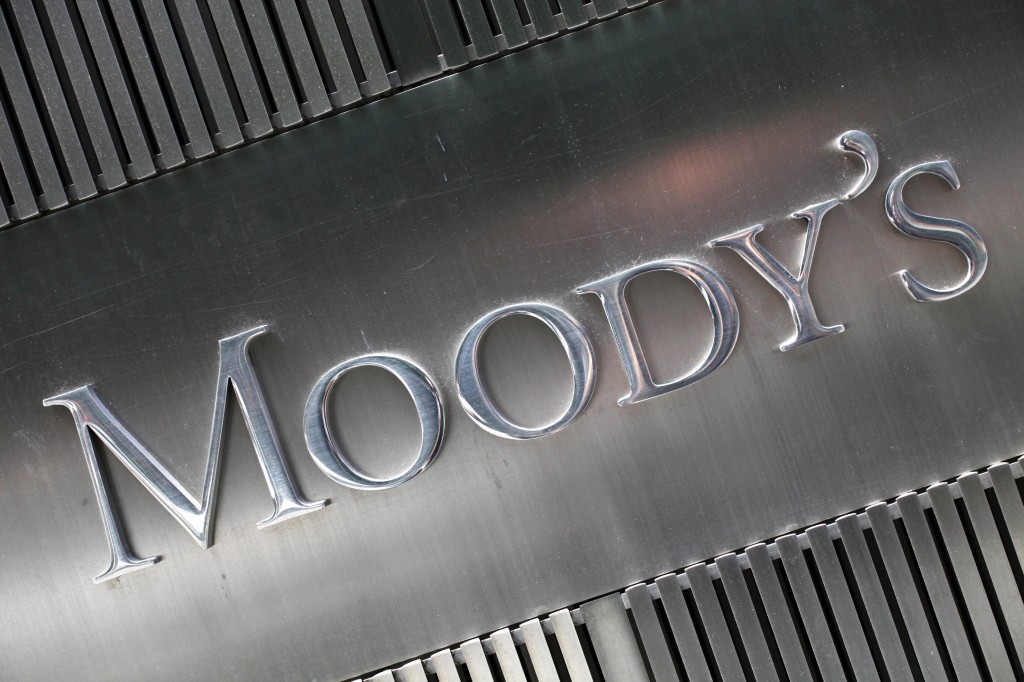
This Aug. 13, 2010 photo shows a sign for Moody’s Corp. in New York. AP FILE PHOTO
The Moody’s Investor Service maintained its Baa2 long-term issuer and senior unsecured debt ratings for the Philippines.
In a statement, Moody’s said it is maintaining a stable outlook for the country and is expecting “that the Philippines’ economic performance will remain strong while debt consolidation will continue and foster further convergence of key fiscal metrics versus corresponding peer medians.”
However, it warned against local political developments that might undermine economic growth and institutional strength.
“Moreover, while broad macroeconomic stability has been maintained so far, a number of metrics indicates material capacity constraints that signal a risk of overheating,” it said.
“Moody’s has also affirmed the government’s local currency and foreign currency senior unsecured ratings at Baa2, the government’s foreign currency senior unsecured shelf rating at (P)Baa2 and the senior unsecured ratings for the liabilities of the country’s central bank, Bangko Sentral ng Pilipinas (BSP), at Baa2. The outlook on BSP has been removed,” Moody’s said.
Meanwhile, it said long-term foreign currency bond ceiling will remain at A3, and the short-term foreign currency bond ceiling at P-2.
“The long-term foreign currency deposit ceiling remains at Baa2, and the short-term foreign currency deposit ceiling at P-2,” the statement said. “Furthermore, the long-term local currency bond and deposit ceilings remain unchanged at A2.”
Stable outlook
Moody’s said the stable outlook is based on positive and negative developments in the country’s credit profile.
Among the factors cited is the real GDP growth average of 6.4 percent per year from 2014 to 2016, which is more than twice the median for other Baa2-rated countries.
“We expect growth to be sustained at above 6% per year over the next two years, driven largely by the private sector,” Moody’s said, adding that household consumption will continue to be supported by remittances from overseas Filipino workers.
“Moreover, FDI inflows–which saw a record high in 2016 of $7.9 billion (2.6% of GDP, up 40.7% vs. 2015), but remain lower than in other countries in the region–will provide ongoing diversification of the economy,” it said.
Moody’s said the Philippines will benefit from a young and growing population that will result in stable private consumption growth and a reduction of “aging-related costs on government finances.”
Risks of conflict
“However, downside risks include a worsening of the Islamist insurgency that could lead to an expansion of martial law, undermine domestic business confidence, and disrupt economic activity including in economically significant regions,” it said.
Moody’s said recent events such as the conflict in Marawi “are examples of escalating domestic political risks that could, should they multiply and escalate, undermine institutional strength and, ultimately, economic growth.”
Nevertheless, it said it does not appear to be an immediate concern and or have weighed on economic growth.
“Nor do they appear to have derailed the government’s economic reform agenda; indeed, the Comprehensive Tax Reform Package recently passed through the lower house of Congress, in part due to the intervention of the President,” Moody’s said. “However, the confrontational nature of the administration’s political agenda could potentially reduce the effectiveness of governance, or negatively affect investment and growth.”
“In addition, any further shock to growth in the GCC (Gulf Cooperation Council) region could reduce remittance inflows. And US policies that could encourage onshoring of jobs could have a negative impact on BPO exports,” it said. KS